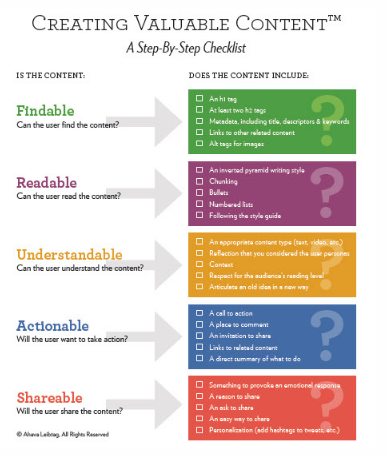 I love checklists because I’m always forgetting things. Once I published a post without a title. Yesterday I almost forgot to hyperlink anything in a post. Fortunately, before I publish I run an analysis for how a post will score with the search engines using Scribe, a great tool.
I love checklists because I’m always forgetting things. Once I published a post without a title. Yesterday I almost forgot to hyperlink anything in a post. Fortunately, before I publish I run an analysis for how a post will score with the search engines using Scribe, a great tool.
Scribe catches everything and tells me things like “there are no primary keywords found.” Yeah, I know that’s ridiculous. But if you don’t use Scribe you could be publishing stuff that search engines don’t grasp.
Here’s a great checklist, just published over at the Content Marketing Institute, authored by Ahava Leibtag.
The checklist is designed for digital content creators and marketing teams, but it can and should be used by anyone writing a business blog or other content for the Web. It defines valuable content using five benchmarks:
If this image is too small, go to the post over at the Content Marketing Institute and download the PDF version.
This is a great checklist to keep handy for anyone creating content for blogs.
For example, there’s a difference between “Readable” and “Understandable” and both are important. Readable refers to formatting, bullet points, etc.
Understandable means you take time to re-read your post with the eyes and brains of your typical readers and take out any ambiguity.
As you can see in this checklist, it’s also important that your content be actionable and shareable. This is similar to what I write about in my ebook, Content Marketing with Blogs. If you haven’t downloaded that yet, be my guest, click here.











